A Complete Guide to Capture Planning from a Bid(Impacting your Bid Decisions) – No Bid Analysis to a Streamlined Gate Process.

Bid decisions aim at eliminating the least qualified sales lead to arrive at the best opportunity to pursue. The high probability of winning (Pwin) on fewer best-fit opportunities permits greater focus on opportunities that can be won.
This article is an effort to break down the capture planning process that precedes proposal submission. The knowledge hereby is dictated by insights gathered and experience gained from our own experience. This article will help you answer the question: How can I help my organization win more business by adopting and adapting proven processes, practices, and tools that can improve our decision-making and reviews?
Topics Covered:
- Importance of Customer focus in the business development lifecycle
- Recommended Review Time Goals
- Business Development Phases and Objectives
- The Purpose of Decision Gates: How does it help achieve Customer Focus?
- Using the Bid Decision Calculator
Customer focus in the business development lifecycle
Customer focus is essential for organizations to grow both in revenue and influence. Organizations can improve customer focus by leveraging aligned business development processes with customers buying processes. Such aligned business development strategies have huge benefits. Let’s analyze the chart below to understand it better in terms of revenue impact.
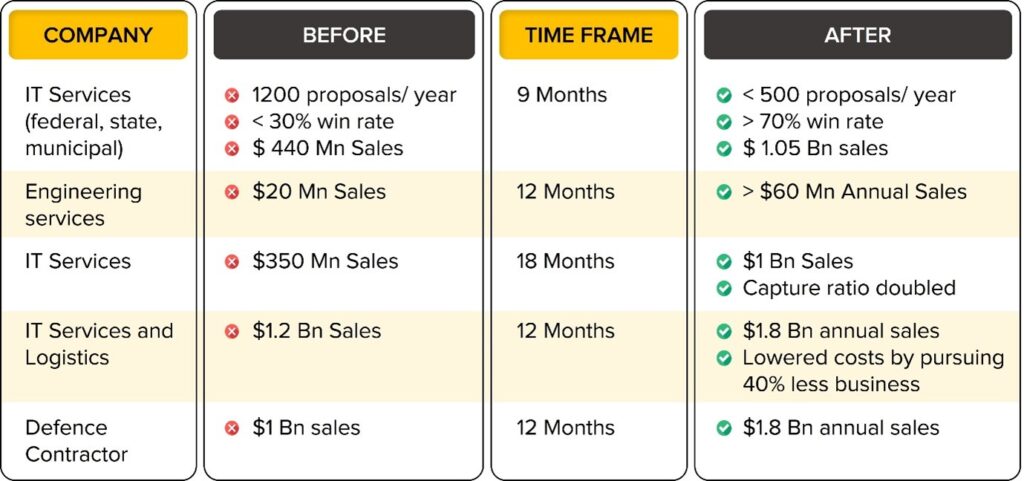
Understanding the customer Buying Cycle adds an advantage in designing Customer Focus business development strategies for the organization. Having limited resources is another reason organizations must focus on the BEST opportunities.
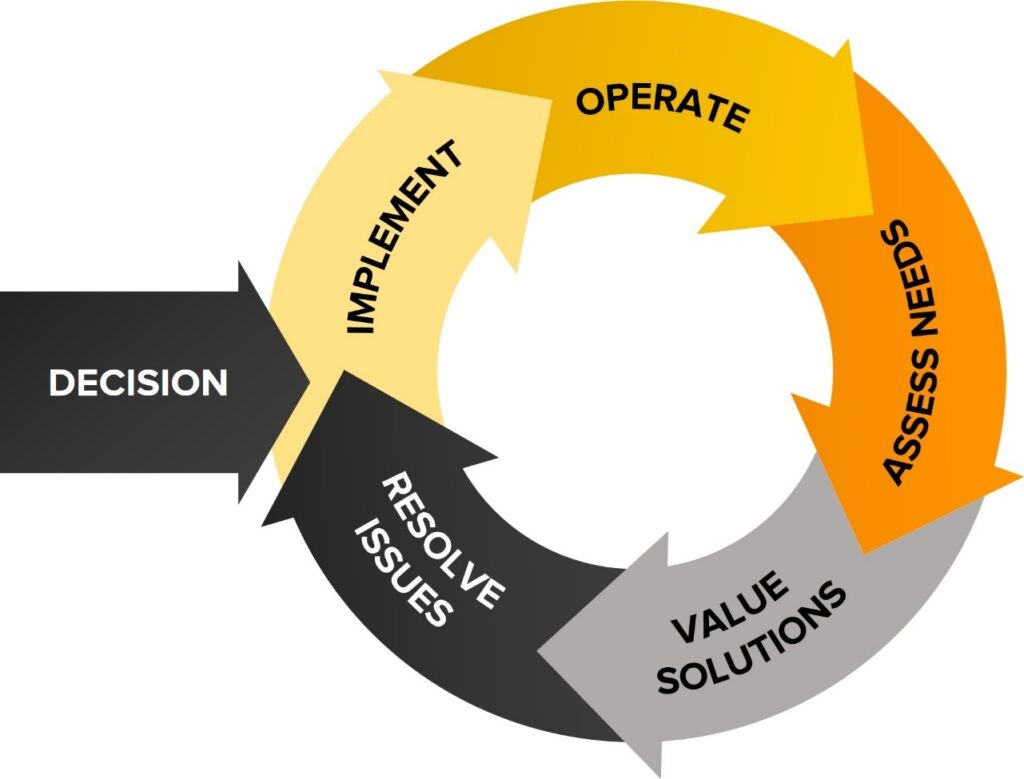
Recommended Review Time Goals
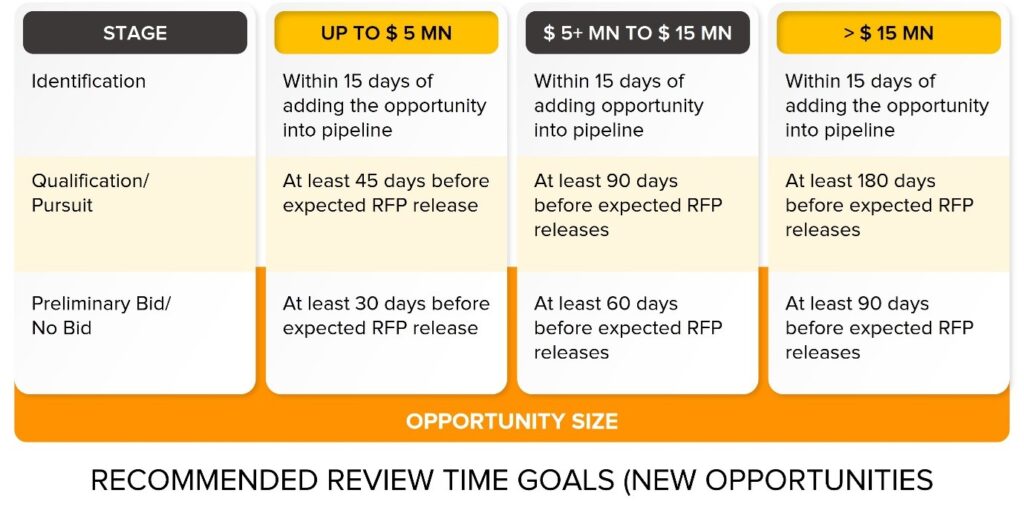
Depending upon the size of the opportunity, organizations take decisive actions regarding time investment to identify the opportunity, if it qualifies for pursuit and preliminary Bid – No Bid analysis.
Business Development Phases and Objective
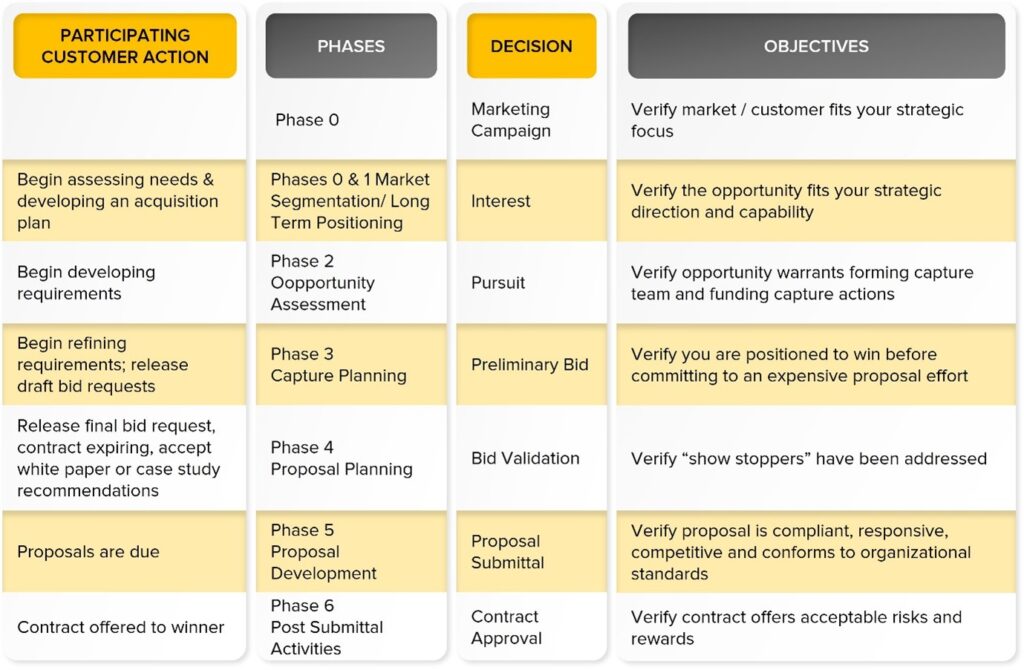
Phase 0: Market Business Segmentation Development:
- Identify and analyze strategic market areas or customers
- Divide market into segments with similar needs, characteristics
- Develop marketing approach aligned with customers expectations Decide to pursue market or customer
Phase 1: Long-Term Positioning Decision to enter market
- Establish place in market Influence potential customers perceptions
- Prospect for leads Decide specific opportunity is of interest
Phase 2: Opportunity Assessment Decision to assess opportunity
- Research opportunity, customer, and competition to determine win potential
- Confirm alignment with capabilities and strategic direction
- Decide to pursue opportunity
Phase 3: Capture Planning Decision to pursue
- Prepare, review, and implement capture plan to influence customer
- Move from unknown to known to preferred position with customer
- Decide to plan proposal
Phase 4: Proposal Planning Refine solution and price to win
- Decision to plan proposal Convert capture strategies into proposal messages
- Begin preliminary content planning
- Decide to bid
Phase 5: Proposal Development
- Make clear assignments
- Decision to bid after RFP review
- Plan and approve content
- Draft proposal according to plan
- Review final proposal thoroughly
- Decide to submit proposal
Phase 6: Post-Submittal Activities
- Decision to submit proposal
- Respond to customer
- Negotiate
- Revise proposal if necessary
- Decide to accept or submit final offer
The Purpose of Decision gates: How does it help achieve Customer Focus?
Decision Gates help implement the opportunity funnel. Their purpose is to help make decisions regarding the allocation or withdrawal of BD resources. The collective effort is generally led by Executives to address business and strategy. Under each phase, critical questions are answered that help understand the organization’s capabilities with respect to the customer buying process.
In the image below, we have charted out questions that each decision gate aims at answering:
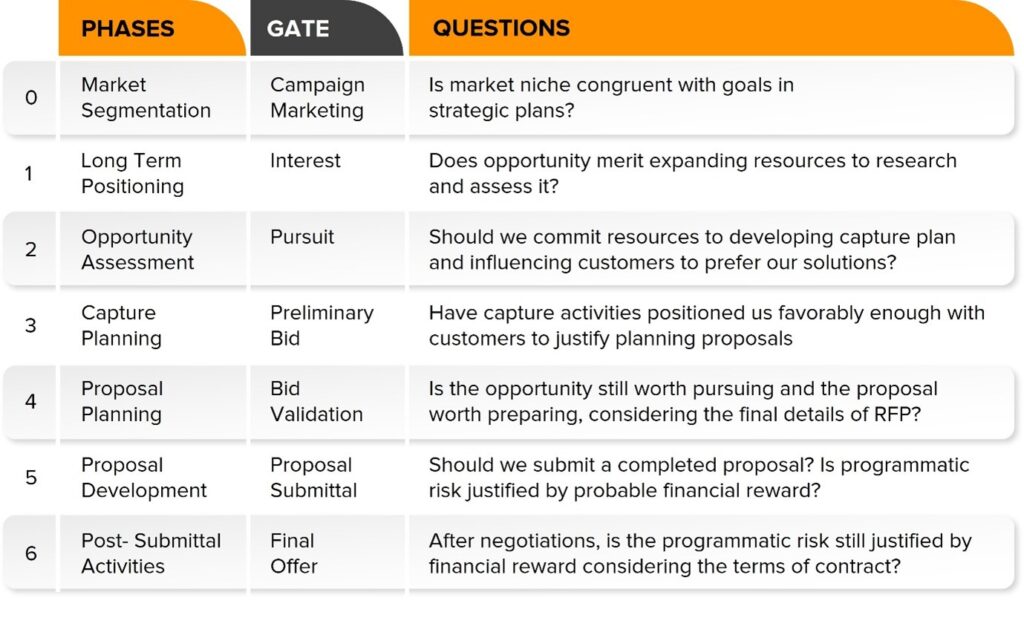
Decision Gates help define business development milestones at which executives get to decide when to advance an opportunity from one phase to the next phase or end pursuit.

Let’s understand how Gate Decisions are Implemented
Gate 0: Marketing/Campaign Decision
The Marketing/Campaign Decision determines whether a potential market segment or customer fits your organization’s strategic focus.
Gate 1: Interest Decision
The Interest Decision verifies that an identified opportunity fits your organization’s strategic direction and capability.
Gate 2: Pursuit Decision
The Pursuit Decision analyzes customer, opportunity, and competitor intelligence to decide when to advance to capture planning.
Gate 3: Preliminary Bid Decision
The Preliminary Bid Decision assesses win strategy, competitive position, technical solution, and price to win, determining whether to plan a proposal.
Gate 4: Bid Validation Decision
The Bid Validation Decision confirms your tentative plan to prepare a bid after seeing the final request for proposals.
Gate 5: Proposal Submittal Decision
The Proposal Submittal Decision determines whether your completed proposal presents your organization and offer acceptably, with risks justified by rewards.
Gate 6: Final Offer Decision
If changes have occurred since your original offer, the Final Offer Decision is your last opportunity to accept or reject the deal.
Using the Bid Decision Calculator

Preparing for a bid is a significant effort in terms of cost and time. Worxwide Bid – No Bid (https://bnbscorecard.bidsandbeyond.com/) Scorecard helps you target the BEST opportunities and alarms you of any risky proposition before you start preparing. The Scorecard allows the key stakeholders to make critical decisions based on multi-dimensional metrics, be it strategy or delivering capability. The tool remembers your preferences and past performances for the next time you bid for a similar opportunity.
Wrap-up
In this article, we have covered information that will help you incorporate decision gates and reviews into your business development process to make it more customer-focused.
We Have Discussed:
- How to use decision gates to select opportunities you can win?
- Apply reviews to improve customer focus and effectiveness
- Described Gate decision review and Schedule gates at different phases.
- Plan and conduct effective gates as per Shipley’s standardized process to your needs.
These skills will help you improve your personal and organizational business development effectiveness.
Final Thoughts
Start with essential milestones and later add steps as you experience success. Implementing Decision Gates can be adapted to your organization’s needs to increase your probability of winning by committing to a Single, Disciplined process that reduces costs, accelerates productivity, improves forecasting, provides increased visibility and help gain insights.
How Worxwide can Help You?
We understand that bidding can be administrative and resource-intensive exercises for the owners of small businesses. Worxwide Consulting will bring APMP-certified professionals to help you prepare and guide you through developing a winning proposal.
Our APMP-certified professionals have 10+ experience in supporting Small Businesses in the United States to bid on contract vehicles, including, GSA FSS, 8(a) STARS, HCaTS, CATS+, GSA MAS, OASIS, NIH CIO-SP3 & CIO-SP4 MOBIS and RMAS. Our proactive team of consultants are well-acquainted with the Federal Market and helping Small Businesses from capture to bid.
tx, USA

London, UK

India


